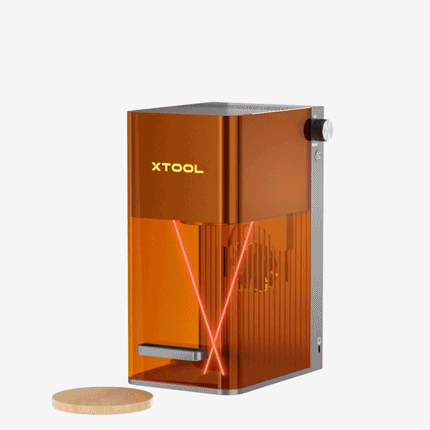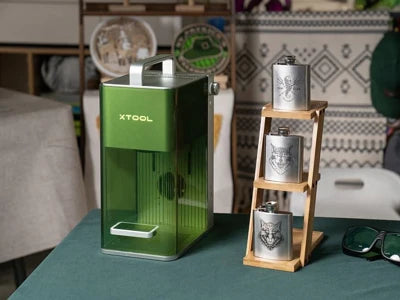The Ultimate Guide To Galvo Laser Engravers
The history of galvanometer systems is fascinating and dates back to about 1820! Who would have thought that technology with such a rich and lengthy past would be so relevant and exciting over 200 years later?
The galvanometer was discovered when a Danish Physicist discovered that a magnetic compass needle would deflect when it was near a wire with an electrical current running through it.
That evolved into a means of long-range communications for the TransAtlantic Telegraph underwater cable system. Galvanometer technology has enhanced several industries including the medical field and is pivotal in discovering the electrical activity of the heart and the brain.
Now, among many modern uses of Galvanometer technology, it has now been adapted into the world of laser engravers and provides some exciting improvements and advantages for many types of laser operations.
In this article, we’ll be discussing galvanometer (galvo) laser engravers and what makes their operation different from other more conventional types of lasers. We’ll also discuss the advantages of owning a galvanometer laser compared to the other available types of laser marking systems.
In This Article
- What is a Galvanometer Laser Engraver?
- How Does a Galvanometer (Galvo) System Work in a Laser Engraver?
- Differences Between Galvo Laser Machine and Conventional XY Axis Laser Machine
- What Laser Machine Types Can a Galvanometer (Galvo) be Applied to?
- Best Galvo Laser Engraver
- Conclusions
What is a Galvanometer Laser Engraver?
Before we dig in, let's define a couple of terms:
Galvanometer
An instrument for detecting or measuring a small electric current by movements of a magnetic needle or of a coil in a magnetic field.
One of the most common uses of a galvanometer is in analog measurements of current, which most people refer to as an ammeter.
Galvanometer Laser
A galvanometer laser, when it detects a small electric current it then deflects and directs the laser light to the intended marking surface by utilizing a mirror or system of mirror arrays.

image credit: stylecnc.com
How Does a Galvanometer (Galvo) System Work in a Laser Engraver?
In a galvo laser engraving machine, the mirror or mirror array rotates to adjust the angle of the laser light. Galvo lasers typically have the advantage over other types of lasers by engraving extremely fast.
When the galvo mirror senses an electric current it acts like an ammeter, which then deflects a light beam through the mirror which is driven by servo motors. Conversely, a conventional laser moving a single beam along an X and Y axis is considerably slower.
Differences Between Galvo Laser Machine and Conventional XY Axis Laser Machine
A diode laser or a CO2 laser moves along an X and Y axis (side to side, and backward and forward, respectively) in much the same manner as your inkjet printer works. We refer to this XY movement as a “Plotter”.
As mentioned above, the galvo laser works by adjusting the mirror angles and directing the laser light to the intended engraving surface below.
More engraving area can be marked, and it can be accomplished in a much faster period of time than a conventional plotter-type laser system. While a typical diode laser can only engrave the surface that is in contact with the single compressed and focused laser dot.
Another principal difference between the two types of lasers is cost. A galvo laser machine is somewhat more expensive than an XY-type machine due to the inclusion of a precision mirroring system which is servo motor driven.
The beam is then directed through an F-theta focusing lens. This component mix plus the electronic current sensing circuitry are factors in higher manufacturing costs vs. a conventional XY laser system.
Where the entry-level costs for a plotter-type laser can be just a few hundred dollars, with a galvanometer laser system the entry-level costs more, and even more depending on other system variables such as the type of laser marker that it is (i.e. Fiber, CO2, Diode, etc.).
Marking area size also greatly affects galvo laser machine costs. The larger the marking area, the greater the cost. This is obviously due to the complexity of the mirror adjusting system that allows it to cover larger surface areas.
While the cost of a Galvo Laser system is appreciably higher, the main benefit of employing this type of system is a huge reduction in production time. The old adage “Time Is Money” applies here.
For example, when engraving on wood, an intricate vector image that takes nearly an hour on an XY laser machine can be done in just a minute with the help of a galov laser engraver.

Mass production operations can be especially efficient, and the improved accuracy and precision of the galvo marking system reduce the chance for parts rejection due to poor quality markings being applied.
What Laser Machine Types Can a Galvanometer (Galvo) be Applied to?
Galvo technology can be applied to the following types of lasers:
- Fiber Laser
- CO2 Laser
- Blue Diode Laser
- Diode-Pumped Solid-State Laser ( such as 1064nm Infrared (IR) Laser)
They are capable of processing different materials due to their characteristics. Fiber galvo lasers are efficient at marking metals, as are 1064 nm IR lasers. 1064 IR lasers are also excellent in engraving plastics. Diode lasers are typically used in engraving wood, leather, stone, and more materials.
Best Galvo Laser Engraver
With regards to the last two lasers mentioned, there is currently a Laser in development that contains both a 10-watt, 455 nm diode laser and a 2-watt 1064 nm IR laser. And it is a galvo laser which means it is fast and covers more materials.
This is a major technological breakthrough with a Dual Laser Source and is contained in one small and portable housing. In addition to that, it is super fast and super precise. It is the xTool F1.
xTool F1
F stands for FAST! The xTool F1 provides super fast engraving speed and is hand-held, and portable.
With two different types of lasers available to the operator, almost any type of surface can have engraving or markings applied, and the precision from the galvo mirror system provides unrivaled quality, especially compared to the typical diode laser.
The precision marking system means less waste of material due to poor or non-uniform engraving quality.
The xTool F1 employs a dual mirror array with specialty-coated surfaces. It is also an extremely low-powered device and can be operated from a portable power supply.
While some laser users operate exclusively at home, many laser operators work as vendors at local festivals, events, flea markets, or anywhere that you can set a table or booth up.
Now, for the first time ever, as a vendor, you can personalize items at lightning-fast speeds for customers while they wait. And the xTool F1 is so lightweight and portable that it can be operated nearly anywhere.
The engraving speed maxes out at 3000 millimeters per SECOND. You may get the best results at just around a couple hundred mm per second using an XY-type laser machine. Ultimately, if you relay to your customer that his or her personalized item may be ready for pickup in 30 minutes, they may walk away, never to be seen again.
With the xTool F1 galvo laser, you can produce the same customized item while your customer watches, greatly reducing the chance of losing that impulse buyer. Items such as jewelry, coasters, leather patches, mugs, and cups can be made and delivered immediately and on the spot.
A preview frame can be projected showing the operator exactly where the marking or engraving will occur reducing the chance for alignment and centering errors.
Engraving accuracy achieved by the xTool F1 is a stunning 0.003 mm. The very best precision diode laser engravers can only achieve an engraving accuracy of about 0.01 mm. The percentage difference in accuracy here is an incredible 108% improvement.
Automatic focus adjustment is also a key feature of the xTool F1. Simply input your material thickness to the software ( XCS) and the xTool F1 performs a seamless adjustment. Having to manually focus other types of lasers takes valuable operation time and can sometimes be a frustrating and inaccurate process.

Rotary operations can also be performed by using the xTool RA2 Pro Rotary and can achieve engraving diameter of 120 mm or about 4.2 inches. An RA2 Rotary Pro is available in the xTool F1 Deluxe Package, which also includes one desktop smoke purifier.
Lastly, a safety shield is included which covers the laser operation. The shield filters the damaging wavelength of laser light to prevent injury to the eyes and also reduces and directs smoke away from the engraving or marking operations.
Conclusions
Galvo laser marking systems are extremely fast, extremely efficient, and have improved marking or engraving precision over conventional XY axis movement type lasers.
Production times, especially as it relates to mass production times are greatly reduced allowing for more profits to be realized. Extremely high marking speeds which are unable to be reached by conventional laser marking systems are achieved using galvo technology.
Downtime for machine maintenance periods is almost non-existent further improving potential production output.
With the introduction of the xTool F1, these galvo operations have taken on the ability to be performed almost anywhere due to its small size, low power requirements, and extreme portability.
Focus is performed automatically by only inputting the material thickness of the item to be engraved. A convenient Frame Preview or Graph Outline Preview can be projected onto the engraving surface and nearly perfect alignment and centering operations can be achieved.
While galvo lasers have smaller working areas than conventional XY-axis lasers, many common money-making operations that a laser hobbyist might create fit comfortably within its build plate size.
A galvo laser system is highly recommended for any laser operator to improve efficiency, reduce production times, and maximize profits.

![[Crowdfunding] xTool F1: An Ultra-fast IR & Diode Laser Engraver at Hand xTool F1 galvo laser engraver](https://cdn.shopify.com/s/files/1/0467/7985/9095/t/45/assets/8f73ec77df762ee3bcdecaa76c379351_c0347632faf040c7a557a9455fa6305d_1024x1024-1669887247292.webp?v=1669887248)



